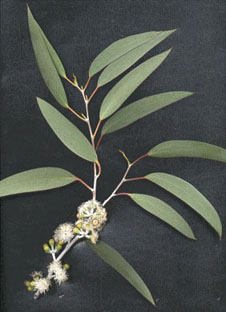| Plant of the Month: February 2002 |
| Cold-hardy Eucalyptus |
| The genus Eucalyptus consists of 500-600 or more species of broadleaf evergreens, nearly all from Australia. Eucalyptus is a member of the Myrtle Family. They are commonly known as gum trees, eucalypts, or by many other Australian names. The genus was named in 1788, from Greek eu, well, and kalyptos, covered, referring to the calyx which first covers the flowers, then falls off like a cap or cover. |
| Eucalypts range in size from sprawling shrubs called "mallees" to the tallest tree recorded in history: a Eucalyptus regnans that measured 435 feet (132 meters) to its broken top in 1872. California's first eucalypts were planted in 1856. In the early days they were used to drain marshy land harboring malaria-carrying mosquitoes, and were grown for timber. Currently the tallest in North America are over 250 feet and at least one trunk measures over 52 feet around. Some specimens have become naturalized in California and are so common in places that they pass as natives. The trees grow tall very rapidly (so fast because they never stop; just slow down in winter); even when frozen to the ground they often resprout well. Lignotubers occur in many species and enable resprouting after the tops are killed by freezing, fire, grazing or cutting. The juvenile foliage featured by many species is very decorative; it is typically powder-bluish, often rounded and stemless, whereas adult foliage tends to be greener and more willowy. Both juvenile and adult foliage is fragrant when crushed -- sometimes from a distance (smelling much like Vick's VapoRub®). |
| Most of the species are comparatively frost-tender, but many have been tested in cold regions such as in Oregon, Washington, British Columbia and England, not to mention Kansas, Ohio and other States usually thought to be too cold for them. Their behavior in the wild, as described in Australian literature, is often dramatically different from their cultivated appearance. None of the hardy species have the showy lipstick-red flowers sported by some of their cold-tender relatives. Eucalypts are drought-tolerant, require much sun, and aside from aphids on a few, are largely pest-free in the Northern hemisphere. The visual and hardiness variation within a species is often confusingly great. Foliage glaucousness varies within a species the same way as it does with blue spruces and many other trees. Frost resistance is subject to a high level of genetic variation. Gradual hardening off in autumn is more critical than how low the mercury plunges in winter. Cultural practices, such as not planting out pot-bound stock, and choosing a site with some protection and superb drainage, also aid a great deal. |
| Our scan shows a floriferous specimen of E. pauciflora, in bloom in Seattle in late January, while snow was on the ground. Ironically its Latin name means paucus (few) and florus (flowered). It is the most cold-hardy species. Try planting either of the following if you desire an exceptionally cold-hardy eucalypt. |
| E. pauciflora (= E. coriacea) Snow gum. White sallee. Ghost gum. Cabbage gum. |
E. pauciflora ssp. niphophila (= E. niphophila) Snow gum. Alpine snow gum. Alpine gum.
Back |

scan by ALJ |
|
|

